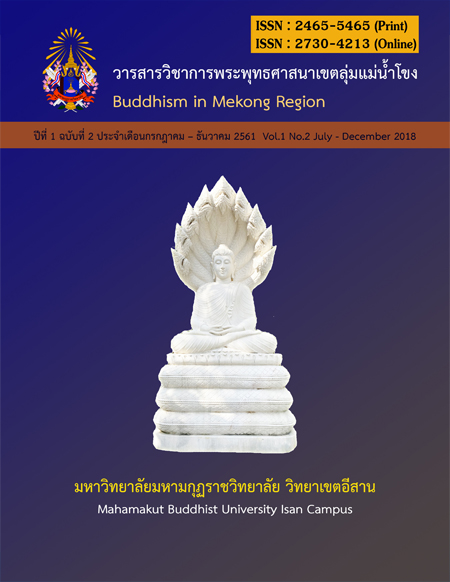The comparison on English reading ability after using fables
Main Article Content
Abstract
The purposes of this study were to study and compare English reading comprehension ability using tales of Mattayomsuksa 1 students before and after the instruction, and to study students’ attitude towards teaching English reading comprehension using comprehension using tales. The sample consisted of 33 students of Mattayomsuksa 1 students at Jaturamitwittayakarn school, Khonkaen Province, in the first semester of the academic year 2017. They were selected by purposive selection. The design of this research was a one group pretest-posttest design. The research instruments included 10 lesson plans, an English reading comprehension ability test, and an attitude questionnaire. The findings were as follows; 1) The students’ pretest and posttest mean scores on English reading ability were 8.06 or 40.30 percentand 25.94or 79.70percent respectively. 2) The posttest score was higher than the criteria of 70 percent and it was significantly higher than that of the pretest at the .01 level.
2.The students’ attitude towards teaching English reading comprehension ability using tales was at a good level.
Article Details
- ผลงานที่ส่งตีพิมพ์จะต้องไม่เคยเผยแพร่ในสิ่งตีพิมพ์อื่นใดมาก่อนและต้องไม่อยู่ในระหว่างการพิจารณาของวารสารอื่น การละเมิดลิขสิทธิ์ถือเป็นความรับผิดชอบของผู้ส่งบทความโดยตรง
- ต้นฉบับที่ส่งตีพิมพ์ต้องเป็นภาษาไทยหรือภาษาอังกฤษเท่านั้น
- ต้นฉบับต้องผ่านการกลั่นกรองโดยผู้ทรงคุณวุฒิและได้รับความเห็นชอบจากกองบรรณาธิการ
- ในกรณีที่เป็นบทความแปล ต้องได้รับอนุญาตจากเจ้าของลิขสิทธิ์ โดยการขออนุญาตให้เป็นไปตามหลักจริยธรรมสากล
- ข้อความ เนื้อหา รูปภาพ และตาราง ที่ตีพิมพ์ในวารสาร เป็นความรับผิดชอบของผู้เขียนบทความแต่เพียงผู้เดียว มิใช่ความคิดเห็นและความรับผิดชอบของกองบรรณาธิการวารสาร กองจัดการ และมหาวิทยาลัยมหามกุฏราชวิทยาลัย วิทยาเขตอีสาน
6. ผลงานที่ได้รับการตีพิมพ์ถือเป็นลิขสิทธิ์ของวารสาร
References
กาญจนา ปราบผล. (2532). การทดสอบและประเมินผลสำหรับครูผู้สอนภาษา.กรุงเทพฯ: จุฬาลงกรณ์มหาวิทยาลัย.
กุลยา ตันติผลาชีวะ. (2541, เมษายน). การเล่านิทาน. วารสารการศึกษาปฐมรัย, 18(4), 10-9.
ฉวีลักษณ์ บุณยะกาณจน. (2544). จิตวิทยาการอ่าน.กรุงเทพฯ: ไทยวัฒนาพานิช.
ฉวีวรรณ คูหาอภินันท์. (2542). เทคนิคการอ่าน(Reading Techniques).กรุงเทพฯ:ศิลปาบรรณาการ.
นันทิยาแสงสิน.(2540). กลวิธีการสอนอ่านเพื่อความเข้าใจภาษาอังกฤษในระดับประถมศึกษา. เชียงใหม่: คณะศึกษาศาสตร์ มหาวิทยาลัยเชียงใหม่.
บุญซมศรีสะอาด.(2545). การวิจัยเบื้องต้น. พิมพ์ครั้งที่ 5. กรุงเทพฯ: สุวีริยาสาสัน.
ปริญญา อึ๋งสกุล. (2545). การพัฒนากระบวนการเรียนรู้ภาษาอังกฤษสำหรับนักเรียนชั้นประถมศึกษาปีที่ 6. วิทยานิพนธ์ปริญญาการศึกษามหาบัณฑิต สาขาวิชาหลักสูตรและการสอน มหาวิทยาลัยบูรพา.
แม้นมาส ชวลิต. (2548). หนังสือเด็ก. กรุงเทพฯ: สมาคมห้องสมุดแห่งประเทศไทย.
รวีวรรณ อังคนุรักษ์พันธุ์. (2543). การรัดทัศนคติเบื้องต้น. ชลบุรี: คณะศึกษาศาสตร์ มหาวิทยาลัยบูรพา.
ล้วน สายยศ และ อังคณา สายยศ. (2551). เทคนิคกาฯวิจัยทางการศึกษา. กรุงเทพฯ: โรงพิมพ์ศูนย์ส่งเสริมวิชาการ.
วนิษา เทียมเมฆ. (2555). นิทาน 2 ภาษาThai-English. กรุงเทพฯ: พีเอ็นเอ็น กรุ๊ป.
วรรณี ศรีสุนทร. (2539). การเล่านิทาน. กรุงเทพฯ: ต้นอ้อ แกรมมี่.
วิเชียร เกตุสิงห์. (2543). หลักการสร้างและวิเคราะห์เครื่องมือวิจัย. นนทบุรี : มหาวิทยาลัยสุโขทัยธรรมาธิราช.
วิเชียร เกษประทุม. (2542). นิทานพื้นบ้าน. กรุงเทพฯ: พัฒนาศึกษา.
ศักดิ์ สุนทรเสนีย์. (2543). เจตคติ.กรุงเทพฯ: ไทยวัฒนาพานิช.
สมปองหลอมประโคน.(2544). การใช้กิจกรรมการเล่านิทานเพื่อส่งเสริมทักษะฟัง-พูด ภาษาอังกฤษและความคงทนในการเรียนรู้คำศัพท์ของนักเรียนชั้นประถมศึกษาปีที่ 5.วิทยานิพนธ์ปริญญาศึกษาศาสตร์มหาบัณฑิตสาขาวิชาหลักสูตรและการสอนมหาวิทยาลัยเชียงใหม่.
สมศักดิ์ ปริปุรณะ. (2542). นิทานสำหรับเด็ก.ราชบุรี: สถาบันราชหมู่บ้านจอมบึง.
สมุทร เซ็นวานิช. (2526).เทคนิคการอ่านภาษาอังกฤษ.กรุงเทพฯ: มหาวิทยาลัยธรรมศาสตร์.
สำนักวิชาการและมาตรฐานการศึกษา. (2551). คู่มือการจัดการเรียนรู้กลุ่มสาระการเรียนรู้ภาษาต่างประเทศ.กรุงเทพฯ: โรงพิมพ์ชุมนุมสหกรณ์การเกษตร แห่งประเทศไทย.
_______ . (2551). ตัวชี้วัดและสาระการเรียนรู้แกนกลางกลุ่มสาระการเรียนรู้ภาษาต่างประเทศ ตามหลักสูตรแกนกลางการศึกษาพื้นฐาน พุทธศักราช2551.กรุงเทพฯ: โรงพิมพ์ชุมนุมสหกรณ์การเกษตรแห่งประเทศไทย.
สุมิตรา อังวัฒนกุล. 2540). แนวคิดและเทคนิควิธีสอนภาษาอังกฤษ ระดับมัธยมศึกษา.กรุงเทพฯ: จุฬาลงกรณ์มหาวิทยาลัย.
สุรางค์ โค้วตระกูล. (2545). จิตวิทยาการศึกษา. กรุงเทพฯ: ด่านสุทธาการพิมพ์.
สุวิมล ดิรกานันท์. (2548). ระเบียบและวิธีการวิจัยทางสังคมคาสตร์แนวทางสู่การปฏิบัติ. พิมพ์ครั้งที่ 5. กรุงเทพฯ: จุฬาลงกรณ์มหาวิทยาลัย.
อรชรวงศ์ษา. (2548). การพัฒนากิจกรรมการเรียนรู้ในกลุ่มสาระการเรียนรู้ภาษาต่างประเทศ (วิชาภาษาอังกฤษ) โดยใช้นิทานพื้นบ้านอีสานเป็นสำหรับนักเรียนช่วงชั้นที่ 3 (ชั้นมัธยมศึกษาปีที่ 2).วิทยานิพนธ์ปริญญาศึกษาศาสตร์มหาบัณฑิต สาขาวิชาหลักสูตรและการสอน มหาวิทยาลัยขอนแก่น.
อัจฉรา วงศ์โสธร. (2544). การทดสอบและการประเมินผลการเรียนการสอนภาษาอังกฤษ.พิมพ์ครั้งที่ 2. กรุงเทพฯ: จุฬาลงกรณ์มหาวิทยาลัย.
อุมาพร ทองเสมอ. (2548). การพัฒนาแบบปีกทักษะการอ่านภาษาอังกฤษโดยใช้นิทานและรูปภาพสำหรับนักเรียนชั้นประถมศึกษาปีที่ 5.วิทยานิพนธ์ปริญญาศึกษาศาสตร์มหาบัณฑิต สาขาวิชาหลักสูตรและการสอน มหาวิทยาลัยขอนแก่น.
Anderson, N. (1999).Exploring second language Issues and Strategies. Toronto: Heinle&HeinlePlublishers.
Anderson, R., &Pearson, C. M. (1999). A schema-theoretic view of basic process in reading comprehension in interactive approaches to second language reading. Edited by PaticiaCarellet at, Cambridge: Cambridge University Press.
Asher, J. (2000). Learning another language through actions: The complete teacher’s guidebook. California: Sky Oaks Productions.
Beaty, J. (1994). Picture Book storytelling: Literature Activities for Young Children. Fort Worth: Harcourt Brace College Publishers.
Callanhan, F. &Clark, L. H. (1988). Teaching in the middle and secondary Schools: Planning for competence. New York: Macmilan.
Carrell, P. L., &Eisterhold,C. (1987). A schema-theoretic view of basic process in reading comprehension in interactive approaches to second language reading. Cambridge: Cambridge University Press.
Chomsky, N. (1965). Aspects of the theory of syntax. Cambridge, Mass:MIT Press.
Crawley, S. J.(1995). Strategies for guiding content reading. New York:A Simon &Schuster.
Cynthia, A. (1997). African American fifth-grade males respond to contemporary realistic children’s literature. Dissertation Abstracts International, 53 (November): 1642-A.
De Vas, G. (1991). Storytelling for Adults. Colorado: Libraries Unlimited.
Goodman, K.(1982). The psychology of second language learning. London: Cambridge University Press.
Guthrie, C. (1977). A study of Kentucky folklore as a resource for high school English programs of the state. Dissertation Abstracts International
Harmer, J. (2001). The practice of English language teaching. Harlow: Pearson Education.
Harris, L., &Smith, C. (1972). Individualizing Reading Instruction: A Reader. New York: Holt, Rinehart and Winston.
Heaton, J. B. (1990) Classroom testing.New York: Longman.
Hedge, T. (2000). Teaching and learning in the language classroom. Oxford: Oxford University Press.
Huge, A, (1989). Test for language teachers. Cambridge: Cambridge University Press.
Johnson, P. (1982). Effect on Reading Comprehension of Building Background Knowledge.TESOL Quarterly, 16(4), 605-627.
Krashen, S. D. (1983). Principle and practice in second language acquisition.Oxford: Pergamon Press.
Lie, A. (1993). Paired storytelling: Integrated approach for bilingual and Englishas a second language students. Texas Reading Report, 16(4), 4-5.
Likert, R. (1932). A technique for the measurement of attitudes. Archives of Psychology, 40(14), 32-35.
Miller, H. (1990). Reading comprehension activities kit. California: The center for Applied Research in Education.
Nuttal, C. (1996). Teaching reading skill in a foreign language. New York: Cambridge University Press.
Pedersen, M. (1995). storytelling and the art of teaching. English Teaching Forum, 33(1), 2-5.
Wallace, C. (1992). Reading. 4
Zaro, J. J. (1995). storytelling. Oxford: Heinemann Publishers, (Oxford).
Zintz, M. V. (1984). The Reading process: The teacher and the learner.Dubuque, IA: Wm. c. Brown.


